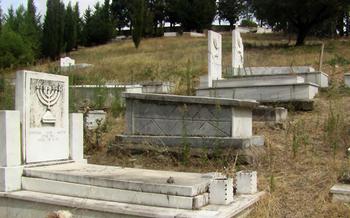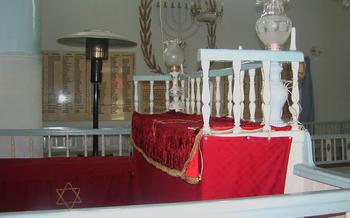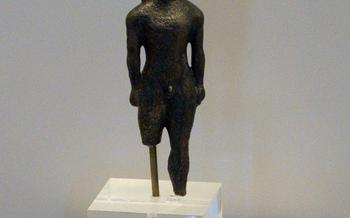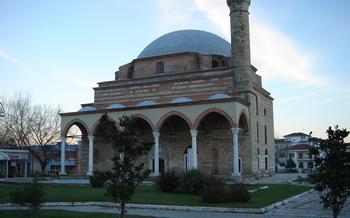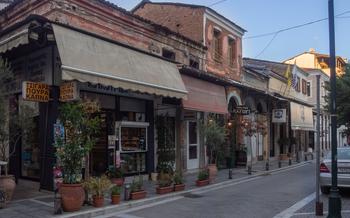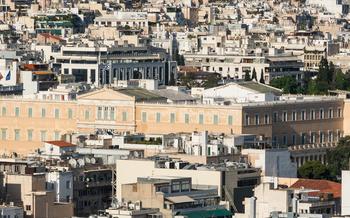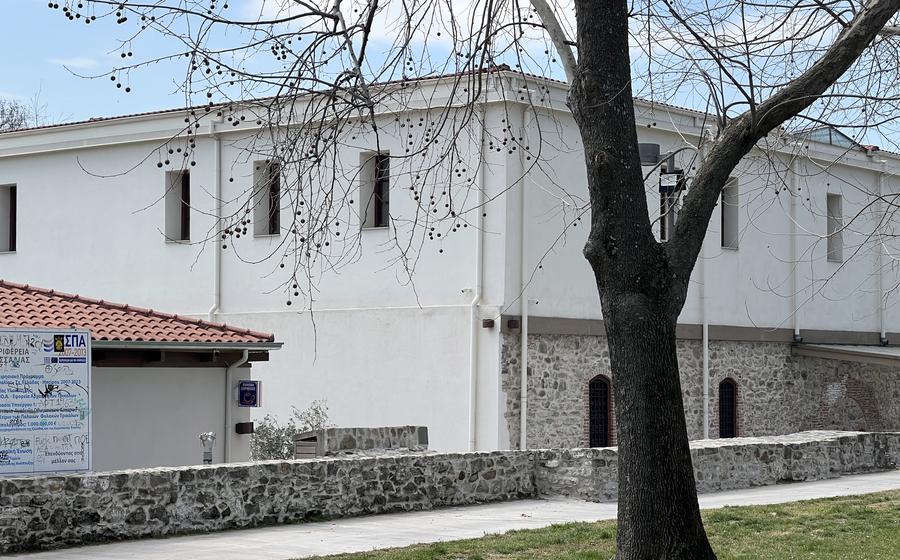
Tsitsani Museum
- Historical Background
- Location and Accessibility:
- Museum Overview
- Exhibits and Artifacts:
- Interactive Displays
- Tsitsanis's Music and Legacy
- Personal Stories and Anecdotes
- Educational Programs and Workshops:
- Guided Tours and Audio Guides
- Museum Shop and Souvenirs
- Events and Performances
- Accessibility for Visitors with Disabilities:
- Surrounding Area and Attractions
- Local Cuisine and Restaurants:
- Insider Tip:
Historical Background
Nestled in the heart of Trikala, Greece, lies the Tsitsani Museum, a cultural gem dedicated to preserving the legacy of Vasilis Tsitsanis, one of the most influential figures in Greek music history. Born in Trikala in 1915, Tsitsanis left an indelible mark on the rebetiko genre, a style of urban folk music that emerged in the early 20th century. Rebetiko, with its poignant lyrics and soulful melodies, captured the struggles and emotions of the marginalized communities in Greece. Tsitsanis, with his exceptional talent and deep understanding of the human condition, became a master of this genre, earning him the title of "The King of Rebetiko." The Tsitsani Museum stands as a testament to his extraordinary life and contributions to Greek music.
Location and Accessibility:
The Tsitsani Museum is conveniently located in the heart of Trikala, at 10 Vasileos Konstantinou Street. Visitors can easily reach the museum on foot, as it is situated within walking distance from the city center and many popular tourist attractions. For those arriving by car, there are several nearby parking options, including on-street parking and private parking lots.
The museum is open to the public from Tuesday to Sunday, with operating hours from 10 am to 1 pm and 5 pm to 8 pm. Admission fees are minimal, making it an affordable attraction for visitors of all ages.
Museum Overview
The Tsitsanis Museum is a captivating cultural institution dedicated to preserving and showcasing the life and legacy of Vasilis Tsitsanis. Located in the heart of Trikala, the museum is housed in a beautifully restored neoclassical building that once served as the city's town hall. The museum's design is both modern and inviting, featuring spacious galleries, interactive displays, and state-of-the-art audio-visual technology.
The museum is divided into several sections, each focusing on a different aspect of Tsitsanis's life and career. The first section introduces visitors to the artist's early years, his family background, and his musical influences. The second section showcases Tsitsanis's rise to fame, highlighting his groundbreaking compositions and collaborations with other legendary musicians. The third section delves into the personal side of Tsitsanis, exploring his relationships, struggles, and triumphs.
The Tsitsanis Museum is not just a repository of artifacts and memorabilia; it is a living testament to the enduring power of Greek music. Through its interactive exhibits, multimedia displays, and educational programs, the museum aims to inspire and educate visitors of all ages, ensuring that the legacy of Vasilis Tsitsanis continues to resonate for generations to come.
Exhibits and Artifacts:
The Tsitsani Museum houses a treasure trove of artifacts that bring Vasilis Tsitsanis's life and music to life. Among the most notable exhibits are his personal belongings, such as his handwritten manuscripts and musical instruments, including the bouzouki, baglamas, and guitar. These artifacts offer a glimpse into his creative process and the evolution of his musical style.
Visitors can also see his stage costumes, record covers, and photographs that capture moments from his performances and everyday life. The museum also displays various awards and accolades that Tsitsanis received throughout his career, showcasing his impact on Greek music and culture.
One of the highlights of the museum is the recreation of Tsitsanis's music studio, where visitors can listen to his recordings and get a sense of the environment in which he created his iconic songs. The museum also features a collection of rare and unreleased recordings, giving visitors a chance to hear hidden gems from Tsitsanis's vast repertoire.
These exhibits and artifacts provide a comprehensive overview of Vasilis Tsitsanis's life and contributions to Greek music, allowing visitors to gain a deeper understanding of his artistry and legacy.
Interactive Displays
The Tsitsani Museum offers several interactive displays that allow visitors to engage with the life and music of Vasilis Tsitsanis in a dynamic way. One of the highlights is the interactive timeline that lets visitors explore key moments in Tsitsanis's career and the evolution of rebetiko music. Through touchscreens and multimedia presentations, visitors can learn about his early years, his collaborations with other musicians, and the impact of his music on Greek society.
Another engaging display is the virtual reality experience that transports visitors back in time to the 1930s and 1940s, the golden age of rebetiko. Using VR headsets, visitors can immerse themselves in the vibrant atmosphere of a rebetiko club, surrounded by musicians and dancers. The experience provides a unique glimpse into the world that shaped Tsitsanis's music and the cultural context in which it flourished.
These interactive elements add a layer of engagement to the museum experience, making it more accessible and enjoyable for visitors of all ages. They allow visitors to connect with Tsitsanis's music on a deeper level and gain a better understanding of the historical and cultural significance of his work.
Tsitsanis's Music and Legacy
Vasilis Tsitsanis left an indelible mark on the rebetiko genre, revolutionizing Greek music with his unique style and poignant lyrics. His compositions explored the themes of love, loss, poverty, and social injustice, capturing the essence of the Greek experience. Tsitsanis's music resonated with the working class and marginalized communities, becoming a symbol of resistance and resilience.
His ability to blend traditional Greek melodies with Western musical influences created a new sound that captivated audiences. Tsitsanis's songs, often performed with his trademark bouzouki, became instant hits, propelling him to stardom. His music transcended national boundaries, influencing musicians and music lovers worldwide.
Tsitsanis's legacy extends far beyond his own career. He paved the way for a new generation of Greek musicians, inspiring countless artists to follow in his footsteps. His music continues to be celebrated and performed, serving as a testament to his enduring impact on Greek culture.
Personal Stories and Anecdotes
The Tsitsani Museum is not just a repository of artifacts; it's a place where the spirit of Vasilis Tsitsanis himself seems to linger. As you wander through the exhibits, you'll find yourself immersed in stories and anecdotes that bring the legendary musician to life.
One particularly poignant tale is that of Tsitsanis's early struggles. Born into a poor family in Trikala, he taught himself to play the bouzouki and began performing at local tavernas. Despite his talent, he faced rejection and criticism from those who didn't understand his unique style of music.
Undeterred, Tsitsanis persevered, and his fortunes eventually changed. In 1936, he released his first record, "Ta kitrina filla," which became an instant hit. From that moment on, his music captivated the hearts of Greeks everywhere.
Another memorable anecdote is about Tsitsanis's relationship with his beloved bouzouki. He named his instrument "Kariofilitsa," after a beautiful woman he had once loved. Tsitsanis believed that his bouzouki had a soul, and he treated it with the utmost care and respect.
These stories and anecdotes offer a glimpse into the personal life of Vasilis Tsitsanis, revealing his determination, passion, and love for music. They serve as a reminder that behind the iconic musician was a real man with a rich and fascinating story.
Educational Programs and Workshops:
The Tsitsani Museum is not just a repository of artifacts; it is also a hub for promoting Greek music and culture through educational programs and workshops. These programs are designed to engage visitors of all ages, from school children to adults, in the rich musical heritage of Greece.
One of the most popular programs is the "Learn to Play the Bouzouki" workshop. Led by experienced musicians, this workshop provides participants with hands-on experience playing this iconic Greek instrument. Participants learn basic chords, strumming techniques, and even get to compose their own melodies.
Another popular program is the "Greek Music History and Appreciation" lecture series. These lectures delve into the history of Greek music, from its ancient roots to the contemporary era. Participants learn about the different genres, famous composers, and the social and cultural context of Greek music.
The Tsitsani Museum also offers special educational programs for school groups. These programs are tailored to the curriculum, allowing students to explore Greek music in a fun and interactive way.
To participate in these programs and workshops, visitors can contact the museum in advance to book a spot. The museum staff is always happy to assist with any inquiries and provide additional information.
Guided Tours and Audio Guides
For a more immersive experience, visitors can opt for guided tours of the Tsitsani Museum. Knowledgeable and passionate guides lead these tours, providing in-depth insights into the exhibits, Vasilis Tsitsanis's life, and the significance of his music. Guided tours are available in various languages, ensuring that international visitors can also fully appreciate the museum's content.
Visitors who prefer a self-guided tour can take advantage of the audio guides offered by the museum. These audio guides are available in multiple languages and provide detailed commentary on the exhibits, allowing visitors to explore the museum at their own pace while still gaining valuable information. The cost of renting an audio guide is minimal, and it's a worthwhile investment for those who want a more personalized experience.
Museum Shop and Souvenirs
The Tsitsani Museum houses a small but well-stocked museum shop where visitors can find a variety of souvenirs and memorabilia related to Vasilis Tsitsanis and his music. These items range from books and CDs featuring his songs to T-shirts, mugs, and other collectibles. The shop also sells unique and exclusive items such as limited-edition prints, signed memorabilia, and handmade crafts inspired by Tsitsanis's life and work.
For those looking for a meaningful keepsake, I highly recommend the museum's collection of vinyl records featuring Tsitsanis's classic songs. These records are not only a great way to experience his music in its original format but also serve as a tangible reminder of his enduring legacy. Additionally, the shop offers a selection of traditional Greek musical instruments, such as the bouzouki and the baglamas, which make for unique and authentic souvenirs.
Events and Performances
The Tsitsani Museum is not merely a repository of artifacts; it is a vibrant hub that actively promotes and celebrates Greek musical traditions. Throughout the year, the museum hosts a variety of special events, concerts, and performances that bring the legacy of Vasilis Tsitsanis and rebetiko music to life.
These events often feature renowned Greek musicians, singers, and dancers who pay tribute to Tsitsanis's music and the broader rebetiko genre. Visitors have the opportunity to witness live performances of classic rebetiko songs, as well as contemporary interpretations and collaborations.
Attending one of these events is an immersive experience that allows visitors to connect with the soul of Greek music and culture. The performances are not just about entertainment; they are about preserving and honoring a rich musical heritage that has shaped the identity of Greece.
Whether you are a music enthusiast, a history buff, or simply someone who appreciates the beauty of Greek culture, I highly recommend checking the museum's calendar for upcoming events. These performances are a wonderful way to deepen your understanding of rebetiko music and to experience the passion and energy that it continues to ignite in the hearts of Greeks and visitors alike.
Accessibility for Visitors with Disabilities:
The Tsitsani Museum is committed to providing an inclusive and accessible experience for visitors with disabilities. The museum features ramps and elevators that ensure wheelchair accessibility to all levels of the building. Accessible restrooms and designated seating areas are also available for the convenience of visitors with mobility impairments. Additionally, the museum staff is trained to assist visitors with disabilities and can provide any necessary assistance to make their visit enjoyable and informative. Visitors with disabilities are encouraged to contact the museum in advance to inquire about specific needs or accommodations. The museum's dedication to accessibility ensures that everyone can explore and appreciate the life and work of Vasilis Tsitsanis, regardless of their physical abilities.
Surrounding Area and Attractions
After immersing yourself in the world of Vasilis Tsitsanis at his dedicated museum, take some time to explore the captivating surroundings of Trikala. A short stroll away, discover the imposing Trikala Castle, perched atop a hill overlooking the city. This Byzantine fortress offers breathtaking panoramic views and a glimpse into the rich history of the region.
For those seeking spiritual enlightenment, the Monastery of Agios Stefanos, situated just outside the city, is a must-visit. This 16th-century monastery boasts stunning architecture, intricate frescoes, and a serene atmosphere that invites contemplation and tranquility.
Art enthusiasts will delight in the Trikala Municipal Art Gallery, showcasing a diverse collection of paintings, sculptures, and contemporary art pieces by local and international artists. Immerse yourself in the vibrant art scene of Trikala and discover hidden gems that will inspire and captivate.
Nature lovers can escape the urban hustle and bustle by venturing to the enchanting Meteora, a UNESCO World Heritage Site just a short drive from Trikala. Marvel at the awe-inspiring rock formations and explore the centuries-old monasteries perched atop these natural wonders.
Create a memorable full-day itinerary by combining your visit to the Tsitsani Museum with these nearby attractions. Trikala offers a harmonious blend of history, culture, and natural beauty, ensuring an unforgettable experience for every traveler.
Local Cuisine and Restaurants:
Trikala's cuisine is a delectable blend of traditional Greek flavors and local specialties. After your visit to the Tsitsani Museum, indulge in a culinary journey at one of the many restaurants in the vicinity. For an authentic Greek experience, try "To Steki tou Ilia," a charming tavern serving mouthwatering grilled meats, fresh seafood, and traditional dishes like moussaka and pastitsio. "To Oinopnevmatiko" is another excellent choice, known for its extensive wine list and delicious meze platters. If you prefer a more casual setting, head to "To Kafeneion tou Tsitsani," a cozy café named after the legendary musician himself, where you can savor traditional Greek coffee and light snacks.
Insider Tip:
For an unforgettable experience, time your visit to the Tsitsanis Museum during the annual Vasilis Tsitsanis Festival held in Trikala. This vibrant festival celebrates the life and music of the legendary artist with live performances, exhibitions, and cultural events that bring the city alive. Immerse yourself in the infectious energy of traditional Greek music, dance, and festivities as Trikala pays homage to its beloved son. Don't miss the chance to witness this extraordinary celebration that honors the legacy of Vasilis Tsitsanis and the enduring spirit of Greek culture.
